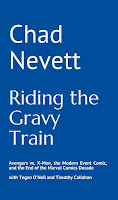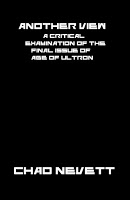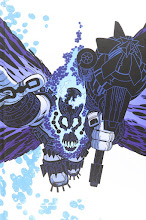[Beginning Art Discussion Month 2010. 31 days, 31 artists, a whole lot of discussion. The explanation behind my choice of comics and the archive can be found here.]
Hellblazer #134-139 ("Haunted"). Written by Warren Ellis. Drawn by John Higgins. Coloured by James Sinclair.
While "Haunted" began Warren Ellis's brief run on Hellblazer, John Higgins had drawn the previous arc, "Son of Man," written by Garth Ennis. However, the visual look of this arc is different because of the nature of Ellis's writing. The plot of "Haunted" is fairly simple: an ex-girlfriend of John Constantine's was killed, he suspects a fellow magician is involved, figures out how to fuck him up, and, then, fucks him up. That it takes six issues for that to play out isn't surprising given Ellis's decompressed style, but the comic is actually about more than simply Constantine encountering his ex-girlfriend's ghost and being haunted by her death. The story is also about John haunting London and how the city haunts him, leading to a very relaxed, meandering style that's reflected in Higgins's art.
The visual look of the book is determined, primarily, by Ellis's decision to push all of the narration to the gutters between panels. This is a technique he lifted off of Frank Miller's Sin City work and possibly Bryan Talbot, as well (I can't find where I saw Ellis mention it...). The first page, as such, features two tall, rectangular panels, one in the top left-hand corner and the other in the bottom right. Beside the first panel is the comic's logo and beside the second panel are the title of the issue and the credits. The panels are placed on a blank white background, an open space that dominates this story. Even the second page, which features a pretty typical Ellis-penned six-panel grid has a lot of gutter space around the panels, a lot of white space. And that page is about as close as we ever get to Higgins filling up a page with art (there are a few cases that go further, but they are rare).
It's not a common practice since most contemporary artists fill up their pages with as much detail as possible, subscribing to the George Perez method of comic art. Take out a copy of The Hard Goodbye by Miller and he doesn't push the narration to the gutters all of the time (or even most of the time) and his pages are much more full. Ellis doesn't use the narration all of the time, but, when he does, the pages become a lot more open. One page in the first issue has two panels, one that extends across the top of the page fully (aside from a little gutter space on either side), taking up the top third of the page maybe; in it, Constantine exits a subway station, backlit so he's mostly shadows. Beneath that panel are three lines of narration that extend across the page. For the remain two-thirds of the page, on the right-hand side is a tall panel that takes up just the right-hand side of the page depicting Constantine as he leaves the station, smoking his cigarette. Placed to line up with the centre of that panel are nine lines of text, leaving large white spaces above and below the text. The following page has three panels, only one of which takes up more than half of the page lengthwise. Lots of white space. This carries on throughout the issue.
It's a very uncommon visual approach, stemming from Ellis, but I'm not sure that Higgins needed to leave as much space. Actually, I'm surprised he did since there's a lot of empty space that many artists would have filled, leaving the bare minimum of empty page space for the letterer to try and cram in. However, Higgins's layouts work with what we see in the panels: Constantine on foot, looking at his surroundings, and walking a little. Constantine doesn't drive, he likes to walk, he likes to take in his environment (the narration on these two pages focusing on discussion of two London neighbourhoods), and the sparce layouts give a similar relaxed feeling, a meandering walking feeling. Instead of making you breeze through the pages, because there's 'less' on it, you take your time a little more, not feeling overwhelmed by a 'wall of sound' of art.
Higgins's other dominant page layout is similar in leaving lots of gutter space as he produces pages where it looks like he drew a bunch of square/rectangular panels, cut them out, and then glued them onto the page with the odd panel corner from one overlapping with the top of the next panel. This doesn't deviate from the 'typical, basic' layouts of two-to-six panels that these comics are built on, but mix things up a little, create a little bit more of that meandering feeling. The walking is a little unsure in those places as you go from panel to panel, directed by the placement of each, and the overlaps.
Toward the end of the fifth issue in this story, when Constantine and his friends begin fucking with Joshua Wright (the magician involved with the ex's death), Higgins piles on the panels, tilting them, creating a sense of confusion and chaos, driving the reader forward quicker, but in an uneasy manner, since they tilt up left-to-right, working slightly counterintuitively since we read left-to-right down, not up.
The shifting of narration to the gutters separates the art and the writing in a way not often done in comics (these days at least) since the narration may relate to what we're seeing, but not necessarily. There's a spot illustration effect, art and words existing together and apart. The words also gain power, because they're given equal weight to the art. While writing is usually emphasised by critics, in the actual physical appearance on the page, the art dominates in most cases. But, when the page layouts have three panels down one side of the page with three chunks of text on the other, the playing field is levelled: the words and art are equal. Higgins makes certain to emphasise that in his layouts, willingly giving the words an equal share of the visual space in a lot of cases.
Even Higgins's line work is simple most of the time. It's very direct, very open, and easy to read. While simple, he doesn't scrimp on the details. His pages don't lack backgrounds or seemed rushed. Since London is a character in this story, he makes sure that all of the settings are fulling realised and shown. His drawings of the London are wonderful as you get a sense of the city (I think), not simply drawing your typical urban environment, making sure to give each section of town its own unique flavour and feeling with different architecture, graffiti, even litter...
He uses shadows quite heavily, but not in a noir fashion. It's tempting to draw Hellblazer as if it were a noir comic at times, I imagine. This story, for example, has Constantine tracking down Wright and doing lots of detective-like activities, and is very much a noir story. Cut out the magic bits, shift the story to LA, and you could easily imagine Philip Marlowe as the lead... But, while Ellis is clearly invoking Raymond Chandler, trying to make Constantine London's version of Marlowe, he's also writing a horror book, which has its own visual rules. The shadows are more menacing, the people more grotesque and freakish...
Higgins draws fantastic faces. When I think about "Haunted" and the art, I come back to his faces. Watford, a semi-corrupt cop that owes John, is a character that you know the minute you see him. A hunched, over-the-hill, boring-haircut-with-a-stupid part man, he practically licks his lips while rubbing his hands creepily discussing how the new Labour government is even better for being a cop than Thatcher's Tories, concluding with the phrase "Lovely jubbly." His nose is too big. He wear a cheap suit. The "Lovely jubbly" panel is one of my favourites.
In the middle of the story, John is listening to a story from a broken down old magician named Haine and he's an ugly old guy. Warts, almost bald, hair growing in the wrong spots, can't keep from drooling a little... and he's dressed almost exactly the same as Constantine. He was Constantine and Constantine will be him. Great visual bit.
His Constantine is very expressive, wearing his emotions on his sleeves, even when he's doing his spooky 'alright, sunshine' stepping out of the shadows bit. He visually feels anger, sadness, surprise, despair... Higgins captures what the characters are thinking quite well.
He also peppers the story with a lot of ugly, horrible bits. A young teenager is trying to get high off of some spray can thing and has a runny nose. Constantine gets bashed in by a couple of thugs and his face is swollen beyond belief. He pukes after and wipes his mouth with his hand, covering it in vomit. He leaves a pile of bloody mucus on a hotel desk. Joshua Wright stumbles down the streets of London, naked, tears and snot covering his face, piss covering the front of his legs, shit covering the back...
Higgins's visual style is distinct. Like most artists, his characters all possess a distinctive look in their faces. Their eyes are rarely fulling open, often shadowed completely, but, otherwise, not fully open. Few faces are symetrical, few attractive. His figures don't move fluidly in the world, often somewhat stiff and overly posed.
There's one big visual mistake that's thrown me since I first read "Haunted." In one scene, Constantine gets revenge on someone who betrayed him a little by putting a scare into him. In one panel, Constantine (just a voice in the room) makes the lighbulb next to the character's head explode. However, Higgins shows us this action from a profile view, putting the light bulb in front of the character's face from our perspective. Since the panel shows the bulb exploding, it's not entirely clear what's happening -- it would have been much clearer to show that from a head-on perspective where we could clearly understand that the character is next to the lightbulb.
James Sinclair's colours are what you'd expect in a Vertigo book. A little drab and heavy in browns and yellows in an attempt to capture a 'realism,' but also to work with the horror nature of the book. But, he does work well with changing the lighting from scene to scene, skin tones coloured differently depending on the setting. I don't have much to say about the colouring here since it doesn't get in the way, but doesn't seem to enhance things too much.
The shifting of the narration to the gutters continues throughout Ellis's run, but subsequent artists handled it a lot differently, so come back over the next few days to see how that particular technique was executed. I hope you enjoyed the first post of the month. I'm not sure all of them will be this long since this is the longest story/largest work of a single artist of the month. Please, let me know what you think (what you liked, what you didn't like, what I can improve on) throughout the month.
Later
Dead X-Men #4 annotations
4 hours ago






